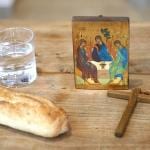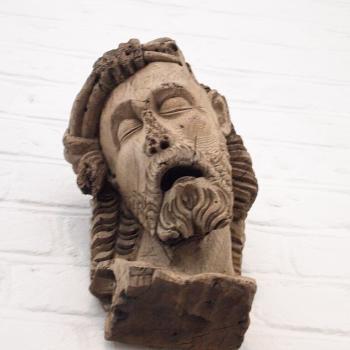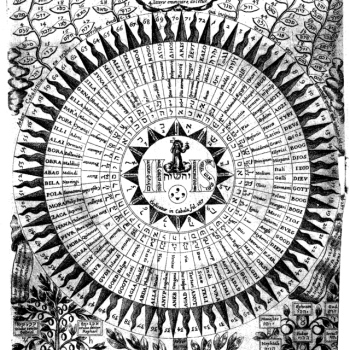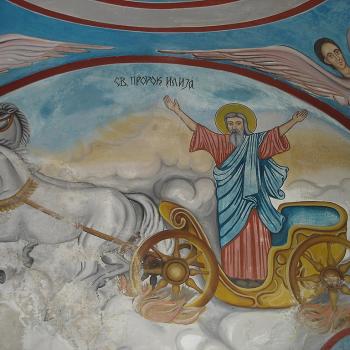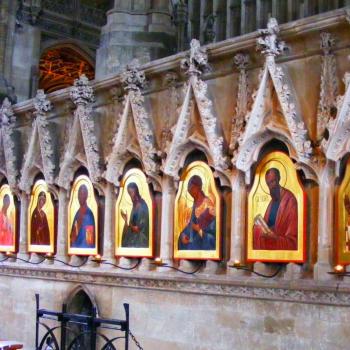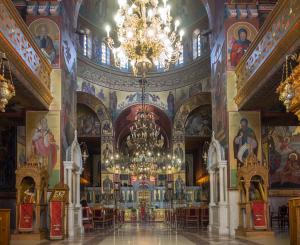
The first Sunday of Lent, the Sunday of Orthodoxy, celebrated the triumph of icons, and in doing so affirmed the value of revelation. God truly has revealed himself to us. God became man and took on a form which we can see. Since we can see it, we can depict it. Now, the second Sunday of Lent, St. Gregory Palamas Sunday, gives us a continuation of this theme. In this way, we continue with our celebration of the triumph of orthodoxy. For, behind all the complex theological and philosophical arguments which St. Gregory Palamas used to defend hesychasm, the point of it all is to affirm that God truly reveals himself to us. We do not need to rely upon something other than God for us to know God. But Palamas’s theology accepts the apophatic thesis that God is greater than what we know about him. God is greater than what we can encounter in his revelation to us. Thus, to affirm the greater mystery of God which lies beyond what we encounter, Palamas presents to us a distinction, that is, between the uncreated energies of God, which we encounter and unite with, and the greater, transcendent essence of God which lies beyond all that we come to know about God.
The iconoclasts warned that God cannot be comprehended by any created being. This is why they said no image could be used to represent him. God is transcendent and therefore uncircumscribed. But, orthodox teaching replies, the incarnations shows us that even if God in his nature transcends all imagining, he is capable of revealing himself to us. We can come to know him and indeed, have ways to imagine him and the glory of the kingdom of God. Likewise, as the saints join in with the glory of God, it shines in and through them. This is why it is not only Jesus, but also the saints are represented and venerated in icons, for in and through them we can perceive elements of the glory of God.
St. Gregory Palamas holds the paradox between God’s transcendence and his ability to engage us and reveal himself to us at the heart of his theology. The problem with iconoclasts is that they got so caught up in God’s transcendent essence, they failed to recognize the ways in which God reaches down and reveals himself to us. Thus, Palamas says, though his essence is transcendent and indeed, cannot be comprehended by us, God in his activities, in his uncreated energies, not only reveals himself to us, but unites himself to us so that we can be deified and partake of his uncreated glory. In summary, Vladimir Lossky writes:
We are therefore compelled to recognize in God an ineffable distinction, other than that between His essence and His persons, according to which He is, under different aspects, both totally inaccessible and at the same time accessible. This distinction is that between the essence of God, or His nature, properly so-called, which is inaccessible, unknowable and incommunicable; and the energies or divine operations, forces proper to and inseparable from God’s essence, in which He goes forth from Himself, manifests, communicates, and gives Himself.[1]
God’s energies are God, for God is simple and undivided. They are not of his nature, but rather, the overflowing powers and acts of his essence which manifest himself to creation. They are uncreated, because God is uncreated. The glory of God which we can encounter is to be understood as an uncreated energy of God. It is not created in time. It is with God in his eternity. In his essence, he transcends it. But in his eternal activity, he presents his glory to all, reaching down from eternity and into time itself. When we encounter it, not only find ourselves coming to know God, but we also find the radiant glory coming to us, willing to share itself with us, allowing us to join in with it and partake of the kingdom of God.
It is important for us to understand that for Palamas, theology should not be about providing some abstract, useless theory about God. Rather, it should explain and represent what we can come to know and experience. Theology should have a practical dimension involved with it. The uncreated energies of God were real, we should pursue them until they are united to us in and through our bodies, making us temples of God, as John Meyendorff indicates:
Since the Incarnation, our bodies have become “temples of the Holy Spirit who dwell in us” (1 Cor 6:19); it is there, within our bodies, that we must seek the Spirit, within our bodies sanctified by the sacraments and engrafted by the eucharist into the Body of Christ. God is now to be found within; He is no longer exterior to us. [2]
God reveals himself to us in and through his uncreated energies, in those actions toward us which allow us to know he is and to be aware of his greatness. God shares himself with his creation, illuminating it out of his gracious love:
It is in creatures – being created from nothing by the divine will, limited and subject to change – that the infinite and eternal energies abide, making the greatness of God to shine forth in all things, and appearing beyond all things as the divine light which the created world cannot contain. [3]
Though most of us begin our search for God indirectly through the vestiges of God in creation (which represent ways in which the uncreated energies of God shine through God’s creation), we must not stop with such an indirect encounter with God. We must pursue the ways we can encounter God within ourselves. What makes a saint a saint is that they realized the glory of God, the uncreated energy of God, in themselves, allowing it to make them holy:
So, when the saint contemplate this divine light within themselves, seeing it by the divinizing communion of the Spirit, through the mysterious visitation of perfecting illuminations – then they behold the garment of their deification, their mind being glorified and filled by the grace of the Word, beautiful beyond measure in His splendour.[4]
Those who have yet to attain such illumination, those beginning their spiritual journey towards the glory of the kingdom of God, must learn how to focus their attention so that they can encounter God within themselves and be illuminated and glorified by that encounter. Thus, Palamas suggests, beginners often need a focal point, such as their breathing, as a way to focus their mind:
On the other hand, it is not out of place to teach people, especially beginners, that they should look at themselves, and introduce their own mind within themselves through control of breathing. A prudent man will not forbid someone who does not as yet contemplate himself to use certain methods to recall his mind within himself, for those newly approaching this struggle find that their mind, when recollected, continually becomes dispersed again. It is thus necessary for such people constantly to bring it back once more; but int his inexperience, they fail to grasp that nothing in the world is in fact more difficult to contemplate and more mobile and shifting than the mind. [5]
Then, when our mind learns how to focus, how to abide in a kind of silence for longer and longer periods of time, it begins to open itself up to God and experience the glory of God which already is within us. Here, Palamas points out, while we must be willing to transcend ourselves, indeed, silence our intellect, in order to experience the transcendent glory of God, that is not the point of our meditation. Rather, we must seek what lies beyond such silence. This is done through our union with the uncreated energies of God:
Contemplation, then, is not simply abstraction and negation; it is a union and a divinisation which occurs mystically and ineffably by the grace of God, after the stripping away of everything from here below which imprints itself on the mind, or rather after the cessation of all intellectual activity; it is something which goes beyond abstraction (which is only the outward mark of the cessation).[6]
Thus, Palamas says, we are not seeking mere inaction through our contemplation, but rather union with the transcendent and eternal activity of God:
As I have said, it is because of their love of men that the saints speak, so far as this is possible, about things ineffable, rejecting the error of those who in their ignorance imagine that, after the abstraction from beings, there remains only an absolute inaction, not an inaction surpassing all action.[7]
And so, following Palamas, we must realize the whole point of our spiritual quest is to find and participate in the kingdom of God. The truth revealed to us in icons is that the glory of God reveals itself to us. Halos on icons represent that glory. It is within the saints even as it is shown above them, transcending them. God is revealed not just in Christ, though of course, there is something primary to that revelation; God is revealed in the sharing of his transcendent glory to the rest of creation, and the various uncreated energies which emerge in that sharing. They are the various powers and names which we associate with God. They reveal God even if God is beyond them as he is beyond all names. Palamas helps us keep the two together, so that we recognize that the economic revelation of God, in all its forms, is true, even if God in his nature or essence transcends his energies. Those energies, however, do more than reveal God to us, they elevate and deify us as we partake of them and join ourselves to them:
All revelation, all participation, all deification is, then, a free act of the living God, a divine energy. But God Himself does not totally identify Himself with that act; He remains above it, even while manifesting Himself wholly in it, for in fact God possesses the creature and communicates to it His own life, but the creature cannot possess God, who always remains the only One who acts. Yet to know the divine essence would be to possess God. The aim of Palamas’ theology is to reconcile two apparently contradictory facts, both integral to patristic tradition.[8]
Palamas shows us that God’s transcendent greatness is one which allows God to share himself with us. Without such an affirmation, it would be easy to turn apophatic theology into a kind of practical nihilism. God shares himself with us. The world is called to participate in the divine life. This means, it is to be united with God and not separate from him. Such a union is not one of nature, for a union between the creature and the essence of God would obliterate creation. Rather, it is union with God’s uncreated glory, his energies. These energies are truly God, not separate from him, but they are not his nature. “They are the outpourings of the divine nature which cannot set bounds to itself, for God is more than essence.”[9] And indeed, God is more than essence, more than a simple monad outside of time and space; God is transcendent to creation and yet also immanent with it. God reaches down and reveals himself to his creation even as he transcends it and is incomprehensible to it. What is known and revealed by God is truly God, so that we are not idolaters when we hold to the truth of revelation, but on the other hand, we know that all that God reveals is not his simple Divine Essence. It is the truth of himself manifest in a form (energy) which we can know. “But he does not consider that the vision of which he has been deemed worth is simply the Divine Nature.“[10] And so we should realize God is always greater, always transcendent, to the form which we are able to encounter. This explains why eternal beatitude will never be boring. For we will find ourselves in an eternal process, an eternal theosis, where we keep encountering greater and greater forms of God’s glory, greater and greater representations of God in his uncreated energies, each which, in turn, will make us greater as we join them to ourselves.
[1] Vladimir Lossky, The Mystical Theology of the Eastern Church. Trans. Members of The Fellowship of St. Alban and St. Sergius (Crestwood, NY: St. Vladimir’s Seminary Press, 2002), 70.
[2] John Meyendorff, St. Gregory Palamas and Orthodox Spirituality. Trans. Adele Fiske (Crestwood, NY: St Vladimir’s Seminary Press, 1998), 107.
[3] Vladimir Lossky, The Mystical Theology of the Eastern Church, 76.
[4] St. Gregory Palamas, The Triads. Trans. Nicholas Gendle (New York: Paulist Press, 1983), 33.
[5] St. Gregory Palamas, The Triads, 45.
[6] St. Gregory Palamas, The Triads, 34-5.
[7] St. Gregory Palamas, The Triads, 36.
[8] John Meyendorff, St. Gregory Palamas and Orthodox Spirituality, 119.
[9] Vladimir Lossky, The Mystical Theology of the Eastern Church, 73.
[10] St. Gregory Palamas, The Triads, 39.
Stay in touch! Like A Little Bit of Nothing on Facebook.
If you liked what you read, please consider sharing it with your friends and family!



